Symptoms And Treatment Options For Heart Attack
Discover the common symptoms of a heart attack and explore effective treatment options. Learn how early intervention can improve outcomes and reduce risks for better heart health.

Written by Dr Shreya Sarkar
Last updated on 3rd Jul, 2025
Heart attack, also known as a myocardial infarction, is a life-threatening disease which occurs when vessels carrying blood to the part of the heart muscle are blocked by a blood clot. Heart muscle tissue is damaged due to the lack of oxygen and nutrients carried by the blood. Knowing the symptoms and early and timely treatments for heart attacks can significantly improve the results of treatment and save lives.
Symptoms of a Heart Attack
Symptoms of heart attack vary widely from one individual to another. Intense symptoms can be seen in some people, while others may have only mild discomfort. Being aware of all these symptoms is very important for early intervention.
1. Chest Pain or Discomfort
The most common and primary symptom of a heart attack is chest pain or discomfort. This discomfort may feel like a squeezing, fullness, or pain in the centre or left side of the chest. The pain often lasts for more than a few minutes or goes away and comes back. It is noteworthy that not all chest pain is a heart attack, but any sudden, severe, or unusual chest pain should be taken seriously.
2. Upper Body Discomfort
Pain or discomfort may radiate beyond the chest to other upper body areas. This can include the arms (especially the left arm), shoulders, back, neck, jaw, or stomach. Such pain can sometimes be mistaken for other conditions, like indigestion or muscle strain.
3. Shortness of Breath
Shortness of breath could occur with or without chest discomfort and is often an early sign of a heart attack. It may happen during rest or physical activity due to the heart's reduced ability to pump blood effectively.
4. Cold Sweat
It is a very common sign to experience a sudden cold sweat in a heart attack. This reaction is part of the body's stress response, activating the fight-or-flight mechanism. Unexplained unreasonable sweating may act as a warning signal and should not be ignored.
5. Nausea or Lightheadedness
Many people encountering a heart attack feel nauseous or lightheaded. This may be accompanied by vomiting. Nausea and lightheadedness are normally ignored, but they are critical indicators of a heart attack.
6. Fatigue
Fatigue, without any heavy work or with little work, is another sign which can precede a heart attack, particularly in women. This type of fatigue can be severe and may not be related to physical or mental activity.
Recognising the Symptoms in Women
Women often experience heart attack symptoms differently than men. Chest pain is a common symptom for both; women are more likely to have other, less typical symptoms such as:
Unusual fatigue
Sleep disturbances
Shortness of breath
Indigestion or gas-like pain
Pain in the back or jaw
These atypical symptoms can occasionally be mistaken for other conditions, leading to delays in seeking treatment. Therefore, it is essential for women to be aware of these differences and seek medical help promptly if they experience any of these symptoms.
Risk Factors for a Heart Attack
There are a few factors which increase the risk of heart attacks. Understanding these factors can help to take preventive measures.
Controllable Risk Factors
Smoking: Smoking increases the risk of heart attacks. Discontinuing smoking is one of the most effective ways to reduce this risk.
High Blood Pressure: Hypertension can damage the arteries, making them more susceptible to blockages.
High Cholesterol: High levels of low-density lipoprotein (LDL) or cholesterol can lead to the buildup of plaque in the arteries, increasing the risk of heart attacks.
Diabetes: Diabetes increases the risk of heart disease and heart attacks. Managing blood sugar levels is crucial for reducing this risk.
Obesity: Excessive weight, mainly around the abdomen, can increase the risk of heart disease. Diet and exercise can help maintain a healthy weight.
Physical Inactivity: Physical inactivity can lead to other factors like hypertension, high cholesterol and obesity, which contribute to heart disease.
Unhealthy Diet: A diet with high saturated fats, trans fats, cholesterol, and sodium can increase the risk of heart attacks.
Uncontrollable Risk Factors
Age: The risk of heart attacks increases with age. Men aged 45 and older and women aged 55 and older are at higher risk.
Gender: While both men and women can have heart attacks, men are at higher risk at a younger age. However, women's risk increases significantly after menopause.
Family History: A family history of heart disease increases the risk of heart attacks. This risk is higher if a parent had a heart attack before age 55 (for men) or 65 (for women).
Ethnicity: Certain ethnic groups, such as South Asians, African Americans, and Hispanics, have a higher risk of heart disease and heart attacks.
Treatments for a Heart Attack
Instantaneous medical attention is critical for treating a heart attack. Here are the standard treatments:
1. Medications
Several medications can be used to treat a heart attack:
Aspirin: To reduce blood clotting and minimise heart damage.
Thrombolytics: These drugs, also known as clot busters, help dissolve the blood clot that's blocking the coronary artery.
Antiplatelet agents: To prevent new clots from forming.
Anticoagulants: Commonly known as blood thinners, these reduce clotting in the blood.
Pain relievers: To alleviate pain and discomfort.
Nitroglycerin: To reduce chest pain and improve blood flow to the heart.
Beta-blockers: To reduce the heart's workload and prevent further damage.
ACE inhibitors: To reduce blood pressure and relax blood vessels.
2. Procedures
There are several procedures which can be used to restore blood flow to the heart:
Angioplasty and Stenting: A long, thin tube (catheter) is inserted into the blocked artery. A balloon on the tip of the catheter is inflated to open the artery, and a stent is often placed to keep it open.
Coronary Artery Bypass Surgery: This surgery creates a new path for blood to flow to the heart. A surgeon takes a healthy blood vessel from another part of the body and uses it to bypass the blocked coronary artery.
Cardiac Rehabilitation: This medically supervised program is designed to improve cardiovascular health after a heart attack. It includes exercise training, education on heart-healthy living, and counselling to reduce stress.
Lifestyle Changes Post-Heart Attack
After a heart attack, it's vital to make lifestyle changes to prevent future occurrences. These changes include:
Healthy Diet
Adopting a heart-healthy diet is essential for recovery and preventing future heart attacks. This diet should include plenty of fruits, vegetables, whole grains, lean proteins, and healthy fats. Reducing the intake of saturated fats, trans fats, cholesterol, and sodium is also crucial.
Regular Exercise
Engaging in regular physical activity helps strengthen the heart and improve overall health. Aim for at least 150 minutes of moderate-intensity aerobic exercise or 75 minutes of vigorous-intensity exercise per week.
Quit Smoking
If you smoke, quitting is one of the most significant steps you can take to improve your heart health. Smoking cessation programs and medications can help you quit smoking for good.
Manage Stress
Chronic stress can contribute to heart disease. Finding ways to manage stress, such as yoga, meditation, deep breathing exercises, or spending time with loved ones, can help improve heart health.
Regular Check-ups
Regular medical check-ups and following your doctor's advice are essential for heart health monitoring. This includes managing any existing conditions, such as high blood pressure, high cholesterol, or diabetes.
Conclusion
Heart attacks are severe medical conditions and require immediate attention. Early detection of symptoms and prompt medical care can save lives. After a heart attack, lifestyle changes and adhering to prescribed treatments can help manage heart health and prevent future attacks. One can take proactive measures to protect one’s heart and overall well-being by understanding the symptoms, risk factors, and treatments.
Consult Top Cardiologist
Consult Top Cardiologist

Dr. Mangesh Danej
Cardiologist
8 Years • MBBS, MD (General Medicine), DNB (Cardiology)
Pune
Dr Danej clinic, Pune
(375+ Patients)

Dr. Amit. A. Bharadiya
Cardiologist
12 Years • MBBS, MD General Medicine, DNB Cardiology, FSCAI
Maharashtra
Surabhi Hospital, Maharashtra, Maharashtra
Dr. Dixit Garg
Cardiologist
10 Years • MBBS , DNB (General medicine) , DNB (cardiology)
Gurugram
Smiles & Hearts, Gurugram

Dr. Pinaki Nath
Cardiologist
8 Years • MBBS, MD General Medicine, DM Cardiology
Barasat
Diab-Eat-Ease, Barasat
Dr. Sibashankar Kar
Cardiologist
10 Years • MBBS, DNB
Bhubaneswar
Hi-Tech Medical College & Hospital, Bhubaneswar




